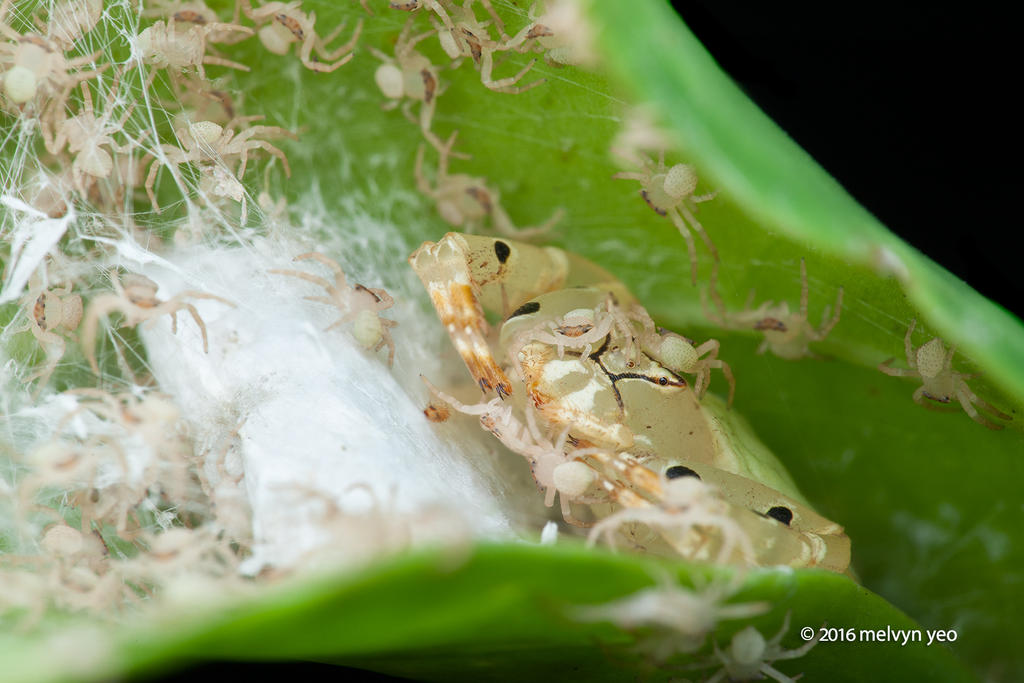ShopDreamUp AI ArtDreamUp
Deviation Actions
Description
Mother Crab Spider with her spiderlings. Taken at night in Singapore forest.
Quote from en.wikipedia.org/wiki/Thomisid…
Rationalisation for the name crab spider is generally subjective and anecdotal. It is commonly said to refer to a fancied resemblance to crabs, or to the way such spiders hold their two front pairs of legs, or their ability to scuttle sideways or backwards. Some spiders so called have bodies that are flattened and angular. At all events, the Thomisidae are the family most generally referred to as "crab spiders". However, some members of the Sparassidae are called "giant crab spiders", the Selenopidae are called "wall crab spiders", and various members of the Sicariidae are sometimes called "six-eyed crab spiders".[3] Some unrelated orb-weaver spider species such as Gasteracantha cancriformis also are commonly called "crab spiders".
Such names are of little biological significance, and the following emphasis is on the Thomisidae.
Thomisidae do not build webs to trap prey, though all of them produce silk for drop lines and sundry reproductive purposes; some are wandering hunters and the most widely known are ambush predators. Some species sit on or beside flowers or fruit, where they grab visiting insects. Individuals of some species, such as Misumena vatia, are able to change color over a period of some days, to match the flower on which they are sitting. Some species frequent promising positions among leaves or bark, where they await prey, and some of them sit in the open, where they are startlingly good mimics of bird droppings. However, these members of the family Thomisidae are not to be confused with the spiders that generally are called bird-dropping spiders, not all of which are close relatives of crab spiders.
Other species of crab spiders with flattened bodies either hunt in the crevices of tree trunks or under loose bark, or shelter under such crevices by day, and come out at night to hunt. Members of the genus Xysticus hunt in the leaf litter on the ground. In each case, crab spiders use their powerful front legs to grab and hold on to prey while paralysing it with a venomous bite.
Quote from en.wikipedia.org/wiki/Thomisid…
Rationalisation for the name crab spider is generally subjective and anecdotal. It is commonly said to refer to a fancied resemblance to crabs, or to the way such spiders hold their two front pairs of legs, or their ability to scuttle sideways or backwards. Some spiders so called have bodies that are flattened and angular. At all events, the Thomisidae are the family most generally referred to as "crab spiders". However, some members of the Sparassidae are called "giant crab spiders", the Selenopidae are called "wall crab spiders", and various members of the Sicariidae are sometimes called "six-eyed crab spiders".[3] Some unrelated orb-weaver spider species such as Gasteracantha cancriformis also are commonly called "crab spiders".
Such names are of little biological significance, and the following emphasis is on the Thomisidae.
Thomisidae do not build webs to trap prey, though all of them produce silk for drop lines and sundry reproductive purposes; some are wandering hunters and the most widely known are ambush predators. Some species sit on or beside flowers or fruit, where they grab visiting insects. Individuals of some species, such as Misumena vatia, are able to change color over a period of some days, to match the flower on which they are sitting. Some species frequent promising positions among leaves or bark, where they await prey, and some of them sit in the open, where they are startlingly good mimics of bird droppings. However, these members of the family Thomisidae are not to be confused with the spiders that generally are called bird-dropping spiders, not all of which are close relatives of crab spiders.
Other species of crab spiders with flattened bodies either hunt in the crevices of tree trunks or under loose bark, or shelter under such crevices by day, and come out at night to hunt. Members of the genus Xysticus hunt in the leaf litter on the ground. In each case, crab spiders use their powerful front legs to grab and hold on to prey while paralysing it with a venomous bite.
Image size
1600x1067px 1.06 MB
Make
Canon
Model
Canon EOS 5D Mark II
Shutter Speed
1/160 second
Aperture
F/16.0
Focal Length
100 mm
ISO Speed
100
Date Taken
Dec 30, 2016, 11:04:14 PM
Sensor Size
10mm
© 2017 - 2024 melvynyeo
Comments8
Join the community to add your comment. Already a deviant? Log In
So cute♡♡♡♡



































